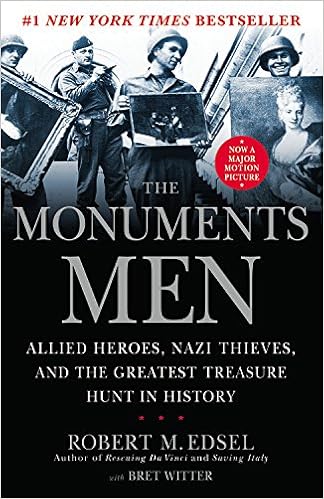
The history of World War II contains many dimensions that continue to be discovered or revisited. Robert M. Edsel writes of the 350 men and women that helped to retrieve and save the most historic pieces of artwork created in art history from Hitler and the Nazis. The Monuments Men: Allied Heroes, Nazi Thieves, and the Greatest Treasure Hunt in History is their story and shows from 1943-1951. But their attempts to preserve the past first came about within the actual buildings that housed these works, churches, museums, and other monuments that became prone to damage during the war. And thereafter during the war, it was their responsibility to locate the five million movable works and cultural artifacts that were stolen by the Nazis, which included works by Leonardo Da Vinci, Jan Vermeer, Rembrandt, Michelangelo, and Donatello and the pieces that were the highlight of Edsel’s book, the Ghent Altar pieces, Bayeaux Tapestry, and painting of Mother and Child. For students of art appreciation, to see how history intertwines with art beyond H.W. Janson’s History of Art, Edsel widens the perspective and understanding.
Edsel covers much ground in the hunt to uncover the pieces of art that occurred in France, Netherlands, Germany, and Austria. He does a good job to outline each of the important individuals that were a part of the Monuments Men, which ranged from established and distinguishable persons that were experts in their field of museum and historical preservation and they came from all over the world. Deanne Keller and Frederick Hart and George Stout, Rose Valland, and Robert Posey from America, John Bryan Ward-Perkins from England, and the hundreds involved. And their training such as Stout’s focused on understanding raw materials, degradation and cause of deterioration, and preparation to prevent deterioration and damage, which would be beneficial once he delved in the race against time to save the artworks. Stout applied preservation and conservation and scientific principles to paintings and visual art. However, the Monuments were a different unit from the rest of the forces that served in Europe due to their backgrounds and the resources that they were and were not provided, they served as only advisors and could not impose any orders on any official or rank, and they had limited access to vehicles, offices, support staff, and any back up plans. In essence, they were a unique group in the war.
After reading the Monuments Men, one may have a better appreciation for this part of history. The format of the book provided a great scope of information and visual presentation, which alternated between stories of the Monuments and the origins and the events related to the Third Reich plans and up to the discovery of the artworks. For the Kindle edition, maps may have been helpful and the photographs may have been dispersed within each chapter rather than at the end of the book.
No comments:
Post a Comment